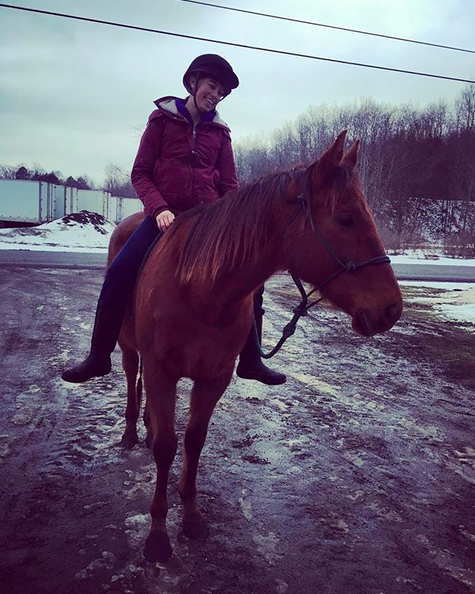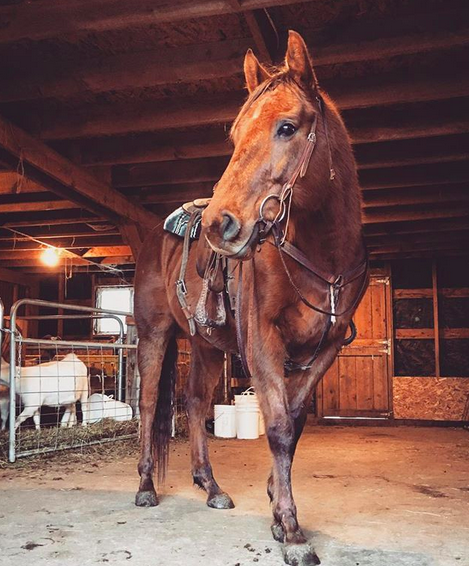
Race Horse to Ranch Horse: Cow Pastures & Cornfields
And all the walking you can shake a stick at.
Regular readers of this column may remember the closing thoughts from my last installment: “Let my lesson learned — truly, my lesson still in progress — serve as an example to all of us: don’t rush. Take your time. Develop your relationship with your horse and remember that he is your partner.”
While in my mind I had been taking it slow and steady all along, it’s important to remember that training isn’t a linear progression — there are plenty of backwards and sideways steps, as well as leaps in totally different directions. There will be plenty more backwards steps, sideways steps and random leaps ahead in the training process.
This is an important philosophy to remember after yesterday’s announcement: 794 trainers have been accepted into the 2018 Retired Racehorse Project Thoroughbred Makeover, and I’m happy to be one of them. I’ve already submitted Jobber’s horse profile for approval — since we’re not in the business of trading horses, let along Thoroughbreds, it’s Jobber or bust for me in the 2018 Makeover. If he proves that he’s not ready by the time October rolls around, I’ll head down to Lexington as a volunteer and continue to pursue showing opportunities closer to home.
Having done my due diligence and hopped right into the thick of the closed Makeover trainers Facebook group, it’s easy to get into the “keeping up with the Joneses” mentality. Already, my newsfeed is full of lovely photos and videos from the other talented trainers in the group, either under warm southern skies or tucked into the shelter of an indoor arena; horses look fat and glossy and miles ahead in their training from where my fuzzy little nugget and I sit, poking our way around the frozen fields of western New York.
But as we all know, comparing oneself to others is never, ever productive. And in our own way, we’ve already accomplished so much.
Cow pastures and cornfields
I said it last time and I’ll say it again: if you are lucky enough to have an indoor arena, please, for my sake, don’t take it for granted. The ability to keep a horse conditioned — no matter what kind of weather is raging outside or what kind of footing Mother Nature has seen fit to bless you with today — should be appreciated by all of us.
On the other hand (admittedly, now that the weather has pumped the brakes on the wild freeze-thaw-freeze cycle and settled back down into freeze with a nice snow cover) I count my blessings in our ranch/farm setup. Fortunately, Jobber is also well acclimated to a northern winter — Canada-breds for the win.
Actual footage of Jobber Bill this month.
I’ve been moving between two spaces right now on the farm depending on the day, weather conditions and personal whimsy.
The cornfield:
- Bigger than the biggest outdoor I’ve ever ridden in, roughly rectangular-ish, bordered on three sides by fences and one side by road
- Currently planted with winter wheat and radish cover crop, fairly smooth-surfaced especially with a snow cover
- Most arena-like space that I have for working on basic exercises, until it’s plowed up and planted in the spring with sweet corn
The cow pasture:
- Currently a winter dry lot for our breeding herd
- Irregular in shape, topography and footing: includes a small stream, hills, cow tracks through wooded sections, and of course, cattle
- Out of direct line of sight with the barn and winter horse paddock
Eventually, I’ll start adding forays back out into our larger pastures again too.
Walking and walking and walking
Since Jobber was largely a pasture puff before I brought him home in November, he was pretty out of shape with very little muscle tone. Knowing I had the mystery of a long winter stretching before me, I made the decision — based in large part on his consistently good mind — to spend about 95% of our saddle time at the walk.
So much conditioning can happen at the walk — especially walking in mid-cannon-bone snow and walking up and down hills. “Walking” doesn’t mean ambling along at whatever speed Jobber chooses, but a nice, forward, uphill walk that covers ground and asks Jobber to track up.
We’ve been walking either under saddle or in hand now since the last Indian-summer days of November, in which I went for a short canter just to get a baseline for what I was working with. Frankly, it was kind of a hot mess: a big, bone-jarring trot that eventually sort of fell into a canter stride that felt as long as a boat and about as easy to steer. Yikes, I remember thinking to myself. This is going to be fun in the spring.
There will be plenty of work to be done at the trot and canter in the springtime, but for now, I’m happy to be “forced” to stick to the basics and build the foundation that will make the faster gaits easier to shape in future months. Here are a few of the things we’ve been working on:
- Transitions within the gait: collected walk, working walk, extended walk (admittedly, sometimes a jig, but we’re getting there)
- Walk-stop-turn: the green horse version of an exercise I used a lot with my reining students, teaching Jobber how to move off of seat and leg while also reminding myself at a slow speed to be absolutely correct in my aids. Also useful when Jobber starts trying to sneak back towards the barn.
- Spirals: working on a gradually-shrinking and then gradually-expanding circle in each direction, working on bending and suppling as well as aids. Especially fun in new snow.
- Obstacles: we worked over a tarp closer to the barn, and in the cow pasture work on navigating the creek bed when it’s open and flowing
- Tracking cattle: especially easy this time of year with the heavily-pregnant slow-moving cows, Jobber is learning the basic cow horse mantra — when the cow moves, you move. When the cow stops, you stop.
- Getting comfortable again being out of sight/out of earshot of the rest of the herd
- Standing by the road and letting the cars whiz by: while our road isn’t necessarily busy, we do have a diesel mechanic right across the street from us with semi-trucks coming and going regularly… as well as the large equipment of our working farm. Occasionally this also develops into “standing quietly while neighbors pull over to chat” — yep, it’s one of those kinds of country neighborhoods.
- Generally goofing off: dorking around in various pens and paddocks at liberty, ambling up and down the driveway bareback in a halter, posing for constant photos and snuggling. This is kind of stuff that seems like a cop-out on the days I don’t want to saddle up, but is actually important for building the relationship.
So much can be done without trotting and cantering endless drills, especially on questionable footing — it’s hard (though not impossible) to injure a horse at the walk.
October is a long way away, and my primary goal is still to create a solid working partnership around the farm before we start to worry too much about Kentucky. That said, I’m excited to be among this year’s Thoroughbred Makeover trainers, and can’t wait to see where this path takes us.
Follow Jobber Bill’s progress into the western world right here on Horse Nation with plenty of updates to come! Go OTTBs, and go riding.








Leave a Comment